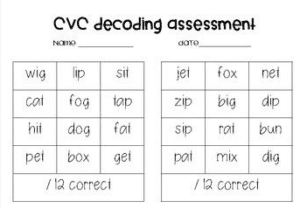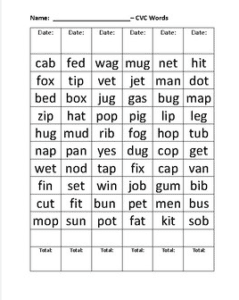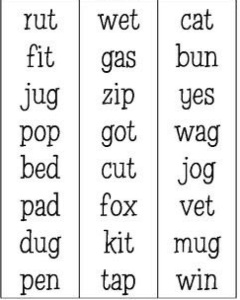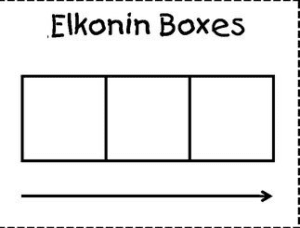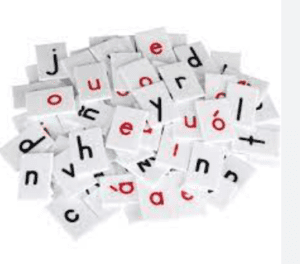Phonics Lesson Plan
| VITAL INFORMATION: Each section of the lesson plans has examples of standards listed: CAEP, InTASC, TGR, TIAI & ISTE. Depending on the type of objectives, instructions, activities, technology, and assessments written in the lesson plan will determine which standards to list.
You are only required to identify the TIAI standard within the lesson plan, but it is a good habit to list all standards that apply. |
|
| Subjects (s) & Topic(s) Covered:
CAEP R1.3; InTasc 7; TGR 1; TIAI 1 |
Subject(s): English Language Arts
Topic(s): Phonic awareness
|
| Grade/Level
CAEP R1.3; InTasc 7; TGR 1; TIAI 1 |
Kindergarten |
| Standards:
Mississippi College & Career Standard(s) Anchor Standard(s) Integrated Standard(s) CAEP R1.3; InTasc 7; TGR 1; TIAI 1 |
CCRS.RF.K.2d: Isolate and pronounce the initial, medial, and final sounds (phonemes) in three-phoneme words (CVC). (Brandy, 2012) |
| Objective(s):
Provide objective for each standard. CAEP R1.3; InTasc 7; TGR 1; TIAI 1
CCR Objective(s) Integrated Objective(s) CAEP R1.2 & R1.3; InTasc 4 & 7; TGR 4; TIAI 3 Social Emotional Objective-Optional |
TSW demonstrates their competence in letter-sound identification by isolating phonemes in three-phoneme words. TSW also substitute individual phoneme in each word with a different phoneme to make new words using the Elkonin sound boxes and manipulative tiles with 80% accuracy. (CCRS.RF.K.2d) (DOK 2) (VERBS) |
| Assessment:
CAEP R1.3; InTasc 6; TGR 3; TIAI 5,7 & 8
Provide feedback on assessments or rubric. CAEP R1.3; InTasc 6; TGR 3; TIAI 7 & 18 |
TTW conducts a pre-and post-assessment using the CVC kits attached to the resources. The informal pre-assessment will help to evaluate students’ weaknesses and strengths in sound isolation and effective substitution to encourage constructive feedback. The informal post-assessment will examine the proficiency of the students in isolation and substitution activities after integrating the learning objectives. |
| Collaboration:
CAEP R1.1; InTasc 3; TGR 5; TIAI 13 |
TTW gives direct instruction to the whole class on how to isolate and substitute sounds in words. TSW also works in groups of four to demonstrate the skills acquired. TSW then works independently to evaluate their competence in the skills rendered. |
| Time Allotment:
CAEP R1.3; InTasc 7; TGR 6; TIAI 24 |
30 minutes |
| Materials:
*Copies of all worksheets, pretest, test, checklist, rubrics & graphic organizer * Answers are provided
|
Student Materials
· Consonant manipulative tiles (7 per student) · Vowel manipulative tiles (3 per student) · Elkonin sound boxes (1 per student)
Teacher Materials · A whiteboard · A projector · 1 dry-erase maker · Sound wall charts · CVC assessment worksheets (2 per student) · Storybook: CAT the CAT Who Is THAT? By Elizabeth Bush |
| Resources:
CAEP R1.1; InTasc 2; TGR 2; TIAI 2 & 4 List websites, title of teacher’s manual(s), student textbook & pictures of scaffolding documents. |
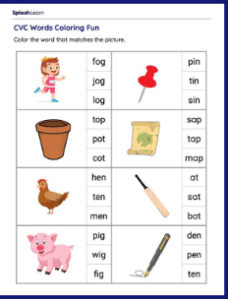
CVC words worksheet
Phonic decoding assessment worksheet
CVC assessment worksheet
Sound wall chart
Elkonin sound boxes
Manipulative letter tiles |
| Key Vocabulary:
CAEP R1.2 & 3; InTasc 4 & 8; TGR 2 &4; TIAI 4 & 14 Vocabulary terms from the scaffolding document and or the content. |
Phoneme- the smallest unit of a speech.
Phonic awareness- involves letter-sound knowledge and the ability to integrate the knowledge in decoding. CVC- words with consonant-vowel-consonant patterns Isolation- separating individual sounds that make a word. Substituting- replacing a specific sound in a word with a different phoneme to build a new word. |
| Research:
APA citation, title & brief summary (Cite research procedures within your lesson plan.) Lesson Plans should incorporate a variety of research strategies. Two samples are provided on the explanation sheet but will not count for an answer.
Unit requirement: Provide a variety of teaching strategies in multiple lesson plans. CAEP R1.1; InTasc 2; TGR 2; TIAI 2 |
Bloom’s taxonomy of measurable verbs
VERBS, C. L. I. Bloom’s Taxonomy of Measurable Verbs. Center for Teaching & Learning| The University of Georgia| ctl. uga. edu, 706, 1355. Common Core Reading Standard Brady, S. (2012). Taking the Common Core foundational standards in reading far enough. Perspectives on language and literacy, 38(4), 19-24. Introductory storybook Bush, E. (2010). Cat the Cat, Who Is That? And: Let’s Say Hi to Friends Who Fly! Bulletin of the Center for Children’s Books, 63(9), 406-406. A video on phoneme isolation Gifted Brain Studio. (2023, July 14). 36 Whole brain reading and phonics: CVC ending sounds final phoneme isolation #learntoread #dyslexia [Video]. YouTube. https://www.youtube.com/watch?v=oq43mkRWPFo |
| IMPLEMENTATION
*You will notice “(Pacing: ___ minutes)” under each section title. Part of planning a successful lesson is pacing. As you plan, you will need to list the anticipated time needed for your 1) Introduction, 2) Procedures, and 3) Closure. They must equal the time listed in the “Time Allotment” section above. |
|
| Introduction/Anticipatory
(Pacing: _10_ minutes) CAEP R1.1, R1.3 & R1.4; InTasc 1,2,3,4,5 & 8; TGR 1,2,4 & 8; TIAI 4 & 14 Use Real Life Connection CAEP R1.4; InTasc 10; TGR 9; TIAI 19 |
TTW starts the lesson by telling the students its goals and objectives. TTW says, “Good morning, class.” TSW responded, “Good morning, teacher.” TTW says, “In today’s phonic lesson, we will learn about sound isolation and substitution. Previously, we learned about the five vowels (a, e, i, o, and u)and numerous consonants. We are going to integrate the learning objectives using three-phonemes words (CVC). We will isolate all sounds that make each word. Later, we will substitute individual sounds in a word with another sound to make different words.” TTW read aloud the introductory story book ‘CAT the CAT, Who Is That?’ by Elizabeth Bush (Bush, 2010). After finishing reading the story, the teacher will say, “Can we mention any CVC word heard from the text?” TTW records students’ responses on the whiteboard. |
| Procedures:
(Pacing: _15_ minutes) CAEP R1.1; InTasc 1,2,3,4,5 & 8; TGR 1,2,4 & 8; TIAI 4, 14 & 17
I Do-Teacher Models thinking skill in sequential order. Scaffolding documents are used or similar content area specific resources. CAEP R1.2 &R1.3; InTasc 8; TGR 2; TIAI 4
Integrates Content into lesson. CAEP R1.2; InTasc 4; TGR 4; TIAI 3
We Do-Teacher & students work together. Guided Practice CAEP R1.2 & R1.3; InTasc 1,2,3,4,5 & 8; TGR 1,2,4 & 8; TIAI 4, 14, 17 & 18
You Do-Student independent practice. If students do not understand, then I will teach it this way… CAEP R1.1 & R1.3; InTasc 1,2,3,4,5 & 8; TGR 1,2,4 & 8; TIAI 4, 14 & 17 Integrates Content CAEP R1.2; InTasc 4; TGR 4; TIAI 3
Enthusiasm by teacher/students CAEP R1.1; InTasc 3; TGR 7; TIAI 12
Cite research procedures within your lesson plan. CAEP R1.1; InTasc 2; TGR 2; TIAI 2
Teacher communicates high expectations- (List questions to be asked and labeled Blooms or DOK (Depth of Knowledge).) CAEP R1.1, R1.2; InTasc 2 & 5; TGR 2 & 4; TIAI 11 & 17
Clear Oral & Written directions are provided. CAEP R1.1; InTasc 3; TGR 4; TIAI 9 & 10
(Unit) In one or two lesson plans Technology is provided-CAEP R1.3; InTasc 7 & 8; TGR 4 & 6; ISTE 5, 6 & 7; TIAI 6 & 15 TC (Teacher Candidate) will offer students a “choice or freedom.” TC will design rubric with students. CAEP R1.1; InTasc 3; TGR 5; TIAI 14 & 17 |
After reading the storybook, the teacher will project a video on phoneme isolation. TTW says, “Pay attention to the illustration in the video I am about to project. The demonstrations support our learning objectives. The video gives you exposure to different ways used by another tutor to integrate our learning objectives.”
I Do As I stated earlier, our learning objective is to increase our phonic awareness skills and knowledge. TTW says, “Focus on the examples that I am going to illustrate how to isolate all sounds in each word.” The first example is the word’ cat.’ “Read the word,” TTW instructs. TSW responds by reading the word aloud. TTW says, “This example has three phonemes, /c/, /a/, and /t/. Read the sounds.” TTW responds by reading aloud the sounds. TTW says, “Another example is the word ‘mat’. The word sounds are /m/, /a/, and /t/. TSW repeats earlier instructions of reading through the word. “Can anyone tell us the differences between the two words?” TTW ask. A student will respond, “The/c/ sound was replaced with the/m/ sound. TTW comments, “Excellent. That is called substituting.” TTW further demonstrates with the words man, van, and pan.
We Do TTW says, “Following the examples I demonstrated, we will work on five examples. At this point, you will use your sound boxes and manipulative letter tiles to represent each phoneme in the words in the boxes. The following are the words we will work on: map, tap, sat, sap, and tan. In each of the words, we will read aloud the word, show each sound in the word with our fingers, and then present the sounds in the sound boxes using our letter tiles. Read the first word.” TSW read the word ‘map’ aloud. “Now show me the sounds in the word using the fingers,” TTW requests. “Now present the sounds in the sound boxes,” TTW says. “Well done,” TTW compliments. The class will repeat the procedure for all the examples.
You Do TTW says, “It is time for everyone to work independently on the following examples: box, pox, fox, nap, gap, hap, dim, dig, pig, dip.” TTW assesses the students’ ability to map the words, correcting the sound boxes one after the other while recording their scores. Also, TTW guides the students in substituting activities by telling the students the sound to replace in a word. TTW says, “Change the /p/ in the word ‘pox’ to /f/. What do you get?” TSW will respond by raising their hands, and the teacher will appoint one at a time to respond to the questions. |
| Closure:
(Pacing: _5_ minutes) CAEP R1.1 & R1.3; InTasc 1,2,3,4,5 & 8; TGR 1,2,4 & 8; TIAI 4 & 14
|
TTW will end the class by helping the students review what they have learned. TTW says, “Based on scores, 90% of the class have developed mastery skills of letter-sound recognition and effective isolation and substitution. The lesson goals are significant in the development of your reading and writing skills. Thank you for your participation in the learning activities. In the next lesson, we will incorporate more effective strategies to address the needs of each individual and help all of you to be at the same learning level.” The teacher will finish computing students’ scores from their assessment worksheets. |
| Differentiation:
CAEP R1.1 & R1.3, 1.4; InTasc 1 & 5; TGR 2; TIAI 16 & 17 Scaffolding documents are used or similar content area specific resources. Research-based activities are preferred in the remediation section. |
Remediation: TTW provides the students with more exams for their practice. TTW works one-on-one with students who require more reinforcement to achieve the expected mastery level. TTW says, “For more practice, you can work on the following words: mud, tax, can, cap, dam, dad, gas, has, cut, cab.” TTW provides the students with constructive feedback to ensure their success in the isolation activity. |
| Enrichment: TTW will provide students with mastery materials to increase their knowledge. TTW guides the students in isolating CCVC and CVCC words, such as ship, trap, bush, song, farm, chop, ball, park, and past. The advanced words will expose the students to more challenging activities, increasing their knowledge. | |
| Professional Responsibilities:
CAEP R1.4; InTasc 10; TGR 9; ISTE 4; TIAI 25 |
The TC will attend skills development programs to improve their teaching skills to help address all students’ learning needs.
The TC will collaborate with their colleagues to share skills on how to integrate specific learning concepts. |
ORDER A PLAGIARISM-FREE PAPER HERE
We’ll write everything from scratch
Question 
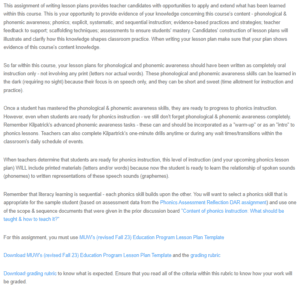
Phonics Lesson Plan
This assignment of writing lesson plans provides teacher candidates with opportunities to apply and extend what has been learned within this course. This is your opportunity to provide evidence of your knowledge concerning this course’s content – phonological & phonemic awareness; phonics; explicit, systematic, and sequential instruction; evidence-based practices and strategies; teacher feedback to support; scaffolding techniques; and assessments to ensure students’ mastery. Candidates’ construction of lesson plans will illustrate and clarify how this knowledge shapes classroom practice. When writing your lesson plan, make sure that your plan shows evidence of this course’s content knowledge.
So far, within this course, your lesson plans for phonological and phonemic awareness should have been written as completely oral instruction only – not involving any print (letters nor actual words). These phonological and phonemic awareness skills can be learned in the dark (requiring no sight) because their focus is on speech only, and they can be short and sweet (time allotment for instruction and practice).
Once a student has mastered the phonological & phonemic awareness skills, they are ready to progress to phonics instruction. However, even when students are ready for phonics instruction – we still don’t forget phonological & phonemic awareness completely. Remember Kilpatrick’s advanced phonemic awareness tasks – these can and should be incorporated as a “warm-up” or as an “intro” to phonics lessons. Teachers can also complete Kilpartrick’s one-minute drills anytime or during any wait times/transitions within the classroom’s daily schedule of events.
When teachers determine that students are ready for phonics instruction, this level of instruction (and your upcoming phonics lesson plan) WILL include printed materials (letters and/or words) because now the student is ready to learn the relationship of spoken sounds (phonemes) to written representations of these speech sounds (graphemes).
Remember that literacy learning is sequential – each phonics skill builds upon the other. You will want to select a phonics skill that is appropriate for the sample student (based on assessment data from the Phonics Assessment Reflection DAR assignment) and use one of the scope & sequence documents that were given in the prior discussion board “Content of phonics instruction: What should be taught & how to teach it?”
For this assignment, you must use MUW’s (revised Fall 23) Education Program Lesson Plan Template
Download MUW’s (revised Fall 23) Education Program Lesson Plan Template and the grading rubric
Download grading rubric to know what is expected. Ensure that you read all of the criteria within this rubric to know how your work will be graded.
If you have experienced difficulty in writing a literacy lesson plan in this course or didn’t receive lesson plan scores that satisfied you, I highly recommend that you review, IN DETAIL, the resources provided on the “Lesson Planning” page in the Pages tab of this Canvas course.
Again – just to clarify – you are not creating an entirely new lesson plan. Instead, you are taking your lesson plan that you started for Phonological & Phonemic Awareness (making sure that you revised it first using the annotated feedback that I gave you on your submitted work/files in the Phonological Awareness assignment and Phonemic Awareness assignment pages) and then adding instruction for Phonics Awareness. If you do not revise your previous submitted lesson plans (using the feedback that I gave you), you will lose even more points (again) on this assignment so REVISING IS REQUIRED. You will keep all of your information for both phonological and phonemic awareness but you may move them to the introduction section to use as a warm and keep the procedures for the bulk of your insruction which will be phonics. Make sure your lesson flows and transitions smoothly. Teachers are decision-makers, so you determine what is the most effective and smooth way to carry out your plan of multiple literacy elements. Teachers in the field are teaching multiple literacy elements within their “reading block” – hopefully, you have observed techniques for integrating and transitioning that may work within this lesson plan.
Just as before, this lesson plan is not written for your residency grade level, but for the given sample student case study that was given to you in the Phonics Assessment DAR assignment.
You will begin this assignment by using your REVISED lesson plan that was submitted on the Phonemic Awareness Activity assignment page. Next, you will enter vital information for the literacy element of Phonics. Finally, you will submit this new document for this assignment.
The vital information in this lesson plan that you will include for the Phonological, Phonemic Awareness, & Phonics activities will be:
- Subject: English Language Arts
- Topic: Phonological Awareness (insert your skill skill here); Phonemic Awareness (insert your skill here); & Phonics (insert your skill here)
- Grade Level: based on the assigned sample student for ECD or EE
- Standards: You will add in a third standard now with your first & second that is based on the sample student’s needs; The standards you select should be for Phonological, Phonemic Awareness, & Phonics of the sample student’s grade level (if the grade level does not have an appropriate standard – 2nd grade may not have some PA – then you can include a previous grade level’s standard – as long as the standard aligns with the specific skill that the student needs instruction
- Remember that your selected phonological & phonemic awareness skills could include one of the following:
- Phonological Awareness: sentence/word awareness, syllables, onset/rime, alliteration
- Phonemic Awareness: phoneme blending, segmenting, isolating, addition, deletion, substitution, reversal
- Beginning Phonics: short vowels, consonant digraphs & trigraphs, double consonant endings, blends, doubling rule, inflectional suffixes, 2 syllable words with short vowels
- Advanced Phonics: schwa, vowel-r, long vowel spelling patterns, diphthongs, hard and soft c and g, consonant -le, silent consonant letters, dropping e to add vowel suffix, derivational affixes
- Remember that your selected phonological & phonemic awareness skills could include one of the following:
- Objective: You will add in a third objective statement now with your first & second ones that use Bloom’s taxonomy
- Download Bloom’s taxonomy for observable & measurable objectives for phonological, phonemic awareness, & phonics
- Assessment: You will add in more procedures that explain, IN DETAIL, how you will assess both phonological & phonemic awareness and now phonics
- In addition to explaining this in the plan, you must also include the actual measurement tools (3 now) that you created to assess the objective(s); On these assessment tools you need titles (naming the assessments’ skill and standards that are being measured) and specific insructions for how the teacher will score the assessment (i.e. how many correct responses are needed to achieve the objective’s % mastery)
- Collaboration: Students will be working with the teacher definitely, may be in whole-group and small-groups, and then will show their understanding independently
- Time Allotment: This length of the lesson will be increased since your first & second plans because your adding more again
- Materials: list out EVERYTHING that will be used within the lesson from start to finish for both phonological & phonemic awareness activities and now phonics; seperate your materials section for each of the lesson’s skills, what is needed for differentiation, and all sections of the plan, including sub sections dividing what is needed for the teacher and student materials; this may include an intro using a storybook that correlates to your skill, lists of picture cards or words, manipulatives, visuals, etc) that are needed for every aspect of the lesson (intro, procedures, closure, remediation, and enrichment); Again, do NOT rely on a worksheet for your primary source of guided instruction – your plan should be “teacher-led” NOT “worksheet-led.” However, if a worksheet is used as an assessment tool or for supplemental purposes, the actual worksheet must be included. This should be scanned in pdf document using the directions provided on the page titled: How to scan documents in pdf format using your phone
- Resources/References: this is where you cite where your ideas and materials came from (for all activities) – these cited resources must be evidence-based (I gave you resources throughout this module, use these and do NOT use Pinterest, TeacherPayTeachers.com, or any other “cute” idea found from a Google search; Do not cite Canvas (a link or a page) as your source – even though I gave the idea here, it is not the original source.
- Introduction: This is where you introduced the storybook, the storybook’s topic or theme, build student’s interest & background knowledge of what’s to come in this lesson’s procedures, & introduced the lesson’s skills; You can keep your same intro storybook but you need to add the teacher’s discussion of how the phonological & phonemic awareness and phonics skills are introduced here too.
- Procedures: This is where you have strategies for building your student’s phonological, phonemic awareness & phonics skills – you should have “best practices” that were given within the course modules (lecture notes and video demos)
- Remember to have your procedures sections divided into “I Do, We Do, You Do” sections as noted in your feedback. Now that you’re adding another standard & objective, you will have increased procedures. Make sure that your third activity follows the same “I Do, We Do, You Do” as the first and second activities. You can arrange these in the procedures section to make it flow but the phonological activity should come before the phonemic activity and phonics should be the last activity (because of the hierarchy of learning these skills).
- Closure: remember to restate the lesson’s purpose, what the students learned, why it is important to learn, and what’s to come next in future instruction
- Differentiation/Remediation/Enrichment: this is where you tell what will be done if the students did or did not master this lesson’s objectives for phonological, phonemic awareness, & phonics; Don’t forget whatever materials you need for this new differentiated approach, must also be list any needed materials
